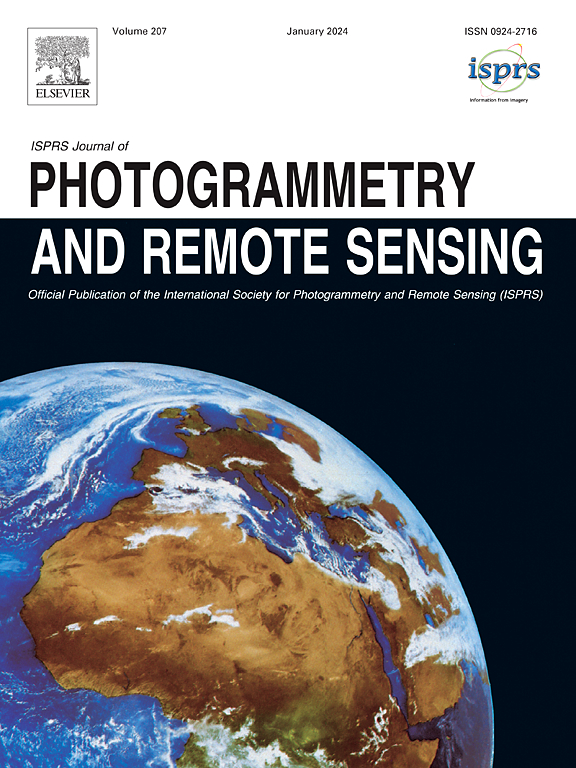Mapping dynamics of large-scale high-precision pond datasets using a semi-automated method based on deep learning
IF 10.6
1区 地球科学
Q1 GEOGRAPHY, PHYSICAL
ISPRS Journal of Photogrammetry and Remote Sensing
Pub Date : 2025-06-27
DOI:10.1016/j.isprsjprs.2025.06.018
引用次数: 0
Abstract
With their large numbers and widespread distribution, ponds are crucial in stormwater interception, biodiversity, and freshwater resource conservation. However, due to their small size and shallow depth, ponds are highly susceptible to anthropogenic activities and climate variability, making it necessary to map their numbers, distribution, and change dynamics. Relying only on deep learning (DL) techniques is insufficient to create a pond identification dataset that does not contain errors. This study is the first of its kind that proposes a workflow to identify small ponds (<5 ha) with minimal errors from the National Agricultural Imagery Program (NAIP) high-resolution aerial imagery using the combination of DL and a manual cross-correction approach. Ponds in South Carolina, United States, were detected and delineated for 2017 and 2019 using U-Net models. Next, the detection results from both years were used as reference data for cross-correction, removing false detections and adding omissions to obtain the refined high-precision pond datasets. The pond datasets were compared to the existing public datasets (JRC and NWI) to evaluate the performance of the proposed method. Finally, changes in ponds between two years and the predominant land cover around each pond in 2019 were analyzed in our study. The results showed that the refined high-precision pond dataset containing 70,449 ponds in 2017 and 71,858 ponds in 2019, with an average size of 0.5 ha, fills an important gap in existing pond data. The existing public datasets (JRC and NWI) do not identify 61.72% and 41.03% of the new high-precision pond dataset developed as part of our study in 2019. Based on land cover data, the largest number of ponds were located in forested areas (23,188 ponds, 0.76 ponds/km2), followed by wetlands (15,782 ponds, 0.76 ponds/km2). In contrast, barren land and hay/pasture had the highest pond density, reaching 2.67 ponds/km2 and 1.93 ponds/km2. A total of 2,979 ponds experienced changes between 2017 and 2019, and 69,664 ponds remained unchanged. The types of pond changes can be categorized as new pond construction, water level changes, and pond disappearance. Our study significantly advances a workflow and method for pond detection that leverages deep learning over large areas in diverse ecological regions and can provide high-precision pond datasets with minimal errors for pond evaluation and management.
基于深度学习的半自动化方法的大规模高精度池塘数据集映射动力学
池塘数量众多,分布广泛,在雨水截流、生物多样性和淡水资源保护方面起着至关重要的作用。然而,由于池塘面积小且深度浅,它们极易受到人为活动和气候变率的影响,因此有必要绘制它们的数量、分布和变化动态图。仅依靠深度学习(DL)技术不足以创建不包含错误的池塘识别数据集。该研究首次提出了一种工作流程,通过结合DL和手动交叉校正方法,以最小的误差从国家农业图像计划(NAIP)高分辨率航空图像中识别小池塘(5公顷)。使用U-Net模型对美国南卡罗来纳州的池塘进行了2017年和2019年的检测和划定。然后,将这两年的检测结果作为参考数据进行交叉校正,去除假检测并添加遗漏,得到精细化的高精度池塘数据集。将池塘数据集与现有的公共数据集(JRC和NWI)进行比较,以评估所提出方法的性能。最后,在我们的研究中分析了两年之间池塘的变化以及2019年每个池塘周围的主要土地覆盖。结果表明,精细化的高精度池塘数据集(2017年为70,449个,2019年为71,858个,平均规模为0.5 ha)填补了现有池塘数据的重要空白。现有的公共数据集(JRC和NWI)不能识别61.72%和41.03%的新高精度池塘数据集,这是我们2019年研究的一部分。林地池塘数量最多(23,188个,0.76个/km2),其次是湿地(15,782个,0.76个/km2)。相比之下,荒地和干草/牧场的池塘密度最高,分别达到2.67和1.93个池塘/km2。2017年至2019年期间,共有2979个池塘发生了变化,69664个池塘保持不变。池塘变化的类型可分为新建池塘、水位变化和池塘消失。我们的研究显著推进了池塘检测的工作流程和方法,该工作流程和方法利用深度学习在不同生态区域的大面积范围内进行,可以为池塘评估和管理提供高精度的池塘数据集,误差最小。
本文章由计算机程序翻译,如有差异,请以英文原文为准。
求助全文
约1分钟内获得全文
求助全文
来源期刊

ISPRS Journal of Photogrammetry and Remote Sensing
工程技术-成像科学与照相技术
CiteScore
21.00
自引率
6.30%
发文量
273
审稿时长
40 days
期刊介绍:
The ISPRS Journal of Photogrammetry and Remote Sensing (P&RS) serves as the official journal of the International Society for Photogrammetry and Remote Sensing (ISPRS). It acts as a platform for scientists and professionals worldwide who are involved in various disciplines that utilize photogrammetry, remote sensing, spatial information systems, computer vision, and related fields. The journal aims to facilitate communication and dissemination of advancements in these disciplines, while also acting as a comprehensive source of reference and archive.
P&RS endeavors to publish high-quality, peer-reviewed research papers that are preferably original and have not been published before. These papers can cover scientific/research, technological development, or application/practical aspects. Additionally, the journal welcomes papers that are based on presentations from ISPRS meetings, as long as they are considered significant contributions to the aforementioned fields.
In particular, P&RS encourages the submission of papers that are of broad scientific interest, showcase innovative applications (especially in emerging fields), have an interdisciplinary focus, discuss topics that have received limited attention in P&RS or related journals, or explore new directions in scientific or professional realms. It is preferred that theoretical papers include practical applications, while papers focusing on systems and applications should include a theoretical background.
 求助内容:
求助内容: 应助结果提醒方式:
应助结果提醒方式:


